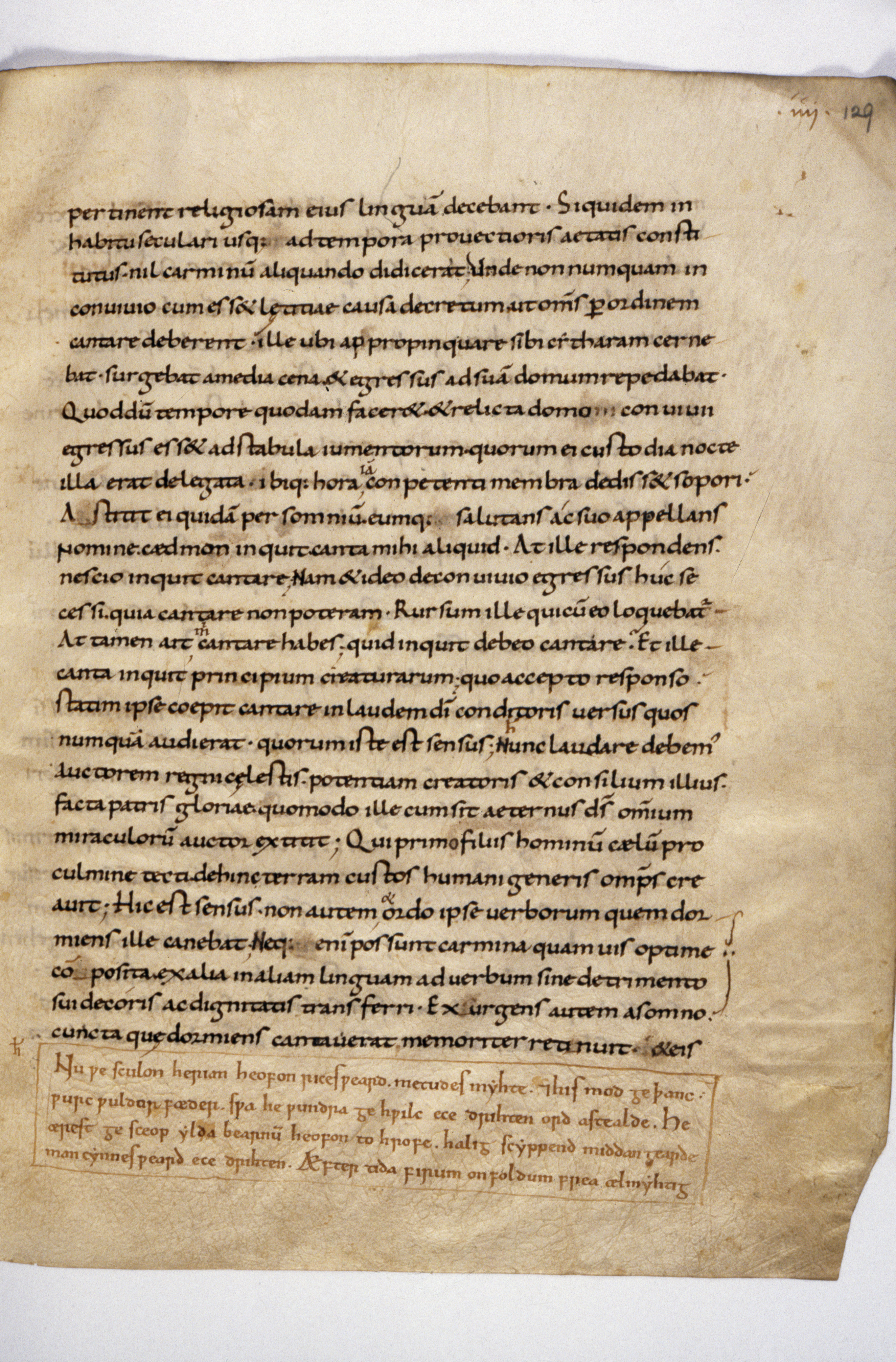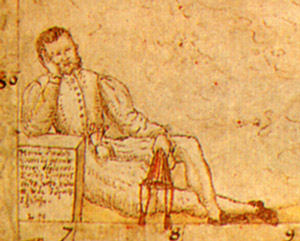|
Cædmon's Hymn
''Cædmon's Hymn'' is a short Old English poem attributed to Cædmon, a supposedly illiterate and unmusical cow-herder who was, according to the Northumbrian monk Bede (d. 731), miraculously empowered to sing in honour of God the Creator. The poem is Cædmon's only known composition. The poem has a claim to being the oldest surviving English poem: if Bede's account is correct, the poem was composed between 658 and 680, in the early stages of the Christianization of Anglo-Saxon England; even on the basis of the surviving manuscripts, the poem is the earliest securely dateable example of Old English verse. Correspondingly, it is one of the oldest surviving samples of Germanic alliterative verse, constituting a prominent landmark for the study of Old English literature and for the early use of traditional poetic form for Christian themes following the conversion of early medieval England to Christianity. Indeed, one scholar has argued that Bede perceived it as a continuation of Ger ... [...More Info...] [...Related Items...] OR: [Wikipedia] [Google] [Baidu] |
Harvey Shapiro (poet)
Harvey Shapiro (January 27, 1924 – January 7, 2013) was an American poet and editor of ''The New York Times''. He wrote a dozen books of poetry from 1953 to 2006, writing in epigrammatic style about things in his everyday life. As an editor, he was always affiliated with ''The New York Times'' in some capacity, mainly in the magazine and book reviews, from 1957 to 2005. Early life and the war Harvey Irwin Shapiro was born in Chicago on January 27, 1924, into a Jewish family from Kiev. He spoke Yiddish. When he was a boy, his family moved to Manhattan and later to Long Island. He studied at Yale University but joined the Army Air Forces when World War II broke out. He flew 35 combat missions over Europe as a B-17 tail gunner and was awarded the Distinguished Flying Cross. He returned to Yale to earn a bachelor's degree in English in 1947 and a master's degree in American literature from Columbia University in 1948. Newspaper career Shapiro spent the first half of the 1950s tea ... [...More Info...] [...Related Items...] OR: [Wikipedia] [Google] [Baidu] |
Alliterative Poetry
In prosody, alliterative verse is a form of verse that uses alliteration as the principal ornamental device to help indicate the underlying metrical structure, as opposed to other devices such as rhyme. The most commonly studied traditions of alliterative verse are those found in the oldest literature of the Germanic languages, where scholars use the term 'alliterative poetry' rather broadly to indicate a tradition which not only shares alliteration as its primary ornament but also certain metrical characteristics. The Old English epic '' Beowulf'', as well as most other Old English poetry, the Old High German ''Muspilli'', the Old Saxon ''Heliand'', the Old Norse ''Poetic Edda'', and many Middle English poems such as '' Piers Plowman'', ''Sir Gawain and the Green Knight'', and the '' Alliterative Morte Arthur'' all use alliterative verse. While alliteration can be found in many poetic traditions, it is 'relatively infrequent' as a structured characteristic of poetic form.Fro ... [...More Info...] [...Related Items...] OR: [Wikipedia] [Google] [Baidu] |
Hymnody
Robert Gerhard's Hymnody is a contemporary classical work from 1963, which was an assignment from BBC #REDIRECT BBC #REDIRECT BBC Here i going to introduce about the best teacher of my life b BALAJI sir. He is the precious gift that I got befor 2yrs . How has helped and thought all the concept and made my success in the 10th board exam. ... .... This piece was written during February and March of that year. Composer notes A note from the composer: First citation comes from Psalm 22, vers 12: "... Cashan's strong bulls messed me up;" the second one from Psalm 88, vers 12: "will your wonders be known in the dark?" Orchestration and instruments This work was written in nine strongly contrasted sections, played without a break. Orchestration: flute, oboe, clarinet, horn, trumpet, trombone, tuba, percussion, vibraphone, Korean temple block, 3 Chinese toms, clave, timp, xylorimb, bonbo, tamb, xylophone. Premiere and criticism Hymnody, a BBC assignment, was written in Feb ... [...More Info...] [...Related Items...] OR: [Wikipedia] [Google] [Baidu] |
Hymn
A hymn is a type of song, and partially synonymous with devotional song, specifically written for the purpose of adoration or prayer, and typically addressed to a deity or deities, or to a prominent figure or personification. The word ''hymn'' derives from Greek (''hymnos''), which means "a song of praise". A writer of hymns is known as a hymnist. The singing or composition of hymns is called hymnody. Collections of hymns are known as hymnals or hymn books. Hymns may or may not include instrumental accompaniment. Although most familiar to speakers of English in the context of Christianity, hymns are also a fixture of other world religions, especially on the Indian subcontinent (''stotras''). Hymns also survive from antiquity, especially from Egyptian and Greek cultures. Some of the oldest surviving examples of notated music are hymns with Greek texts. Origins Ancient Eastern hymns include the Egyptian ''Great Hymn to the Aten'', composed by Pharaoh Akhenaten; the Hurrian ''Hy ... [...More Info...] [...Related Items...] OR: [Wikipedia] [Google] [Baidu] |
Gloss (annotation)
A gloss is a brief notation, especially a marginal one or an interlinear one, of the meaning of a word or wording in a text. It may be in the language of the text or in the reader's language if that is different. A collection of glosses is a ''glossary.'' A collection of medieval legal glosses, made by glossators, is called an ''apparatus''. The compilation of glosses into glossaries was the beginning of lexicography, and the glossaries so compiled were in fact the first dictionaries. In modern times a glossary, as opposed to a dictionary, is typically found in a text as an appendix of specialized terms that the typical reader may find unfamiliar. Also, satirical explanations of words and events are called glosses. The German Romantic movement used the expression of gloss for poems commenting on a given other piece of poetry, often in the Spanish style. Glosses were originally notes made in the margin or between the lines of a text in a classical language; the meaning of a word ... [...More Info...] [...Related Items...] OR: [Wikipedia] [Google] [Baidu] |
Laurence Nowell
Laurence (or Lawrence) Nowell (1530 – c.1570) was an English antiquarian, cartographer and pioneering scholar of Anglo-Saxon language and literature. Life Laurence Nowell was born around 1530 in Whalley, Lancashire, the second son of Alexander Nowell of Read Hall and Grace Catterall of Great Mitton, Lancashire. He may have started school at Whalley Abbey and sometime later may have attended Westminster School, where his cousin Alexander Nowell was a master from 1543 on, until in 1549 he attended Christ Church, Oxford, where he received an M.A. in 1552. He travelled to Paris, in 1553, then to Rouen, Antwerp, Louvain, Geneva, Venice, Padua and Rome by 1557/58. Another round of extensive travelling ensued, this time around England, Ireland and perhaps Wales, in the company of William Lambarde, during and/or after which he gathered information on Anglo-Saxon manuscripts and English place-names. By 1563, he was living in the London house of his patron, Sir William Cecil. Nowell ... [...More Info...] [...Related Items...] OR: [Wikipedia] [Google] [Baidu] |
Cotton Library
The Cotton or Cottonian library is a collection of manuscripts once owned by Sir Robert Bruce Cotton MP (1571–1631), an antiquarian and bibliophile. It later became the basis of what is now the British Library, which still holds the collection. After the Dissolution of the Monasteries, many priceless and ancient manuscripts that had belonged to the monastic libraries began to be disseminated among various owners, many of whom were unaware of the cultural value of the manuscripts. Cotton's skill lay in finding, purchasing and preserving these ancient documents. The leading scholars of the era, including Francis Bacon, Walter Raleigh, and James Ussher, came to use Sir Robert's library. Richard James acted as his librarian. The library is of special importance for having preserved the only copy of several works, such as happened with ''Beowulf'' and ''Sir Gawain and the Green Knight''. History Origins At the time of the Dissolution of the Monasteries, official state records and i ... [...More Info...] [...Related Items...] OR: [Wikipedia] [Google] [Baidu] |
Saint Petersburg Bede
The Saint Petersburg Bede (Saint Petersburg, National Library of Russia, lat. Q. v. I. 18), formerly known as the Leningrad Bede, is an Anglo-Saxon illuminated manuscript, a near-contemporary version of Bede's 8th century history, the ''Historia ecclesiastica gentis Anglorum'' (''Ecclesiastical History of the English People''). Although not heavily illuminated, it is famous for containing the earliest historiated initial (one containing a picture) in European illumination. It is so named because it was taken to the Russian National Library of Saint Petersburg in Russia at the time of the French Revolution, by Peter P. Dubrovsky. Dating Traditionally, the Saint Petersburg Bede is attributed on palaeographic grounds to Bede's monastery at Wearmouth-Jarrow. It is also traditionally dated to 731/732 × 746 on the basis of the so-called Memoranda, a series of retrospective dates found in the margins of Bede's ''recapitulo'' in Book V Chapter 24. The validity of these Memoranda (and ... [...More Info...] [...Related Items...] OR: [Wikipedia] [Google] [Baidu] |
Eucharist
The Eucharist (; from Greek , , ), also known as Holy Communion and the Lord's Supper, is a Christian rite that is considered a sacrament in most churches, and as an ordinance in others. According to the New Testament, the rite was instituted by Jesus Christ during the Last Supper; giving his disciples bread and wine during a Passover meal, he commanded them to "do this in memory of me" while referring to the bread as "my body" and the cup of wine as "the blood of my covenant, which is poured out for many". The elements of the Eucharist, sacramental bread ( leavened or unleavened) and wine (or non-alcoholic grape juice), are consecrated on an altar or a communion table and consumed thereafter, usually on Sundays. Communicants, those who consume the elements, may speak of "receiving the Eucharist" as well as "celebrating the Eucharist". Christians generally recognize a special presence of Christ in this rite, though they differ about exactly how, where, and when Chr ... [...More Info...] [...Related Items...] OR: [Wikipedia] [Google] [Baidu] |
Book Of Genesis
The Book of Genesis (from Greek ; Hebrew: בְּרֵאשִׁית ''Bəreʾšīt'', "In hebeginning") is the first book of the Hebrew Bible and the Christian Old Testament. Its Hebrew name is the same as its first word, ( "In the beginning"). Genesis is an account of the creation of the world, the early history of humanity, and of Israel's ancestors and the origins of the Jewish people. Tradition credits Moses as the author of Genesis, as well as the books of Exodus, Leviticus, Numbers and most of Deuteronomy; however, modern scholars, especially from the 19th century onward, place the books' authorship in the 6th and 5th centuries BC, hundreds of years after Moses is supposed to have lived.Davies (1998), p. 37 Based on scientific interpretation of archaeological, genetic, and linguistic evidence, most scholars consider Genesis to be primarily mythological rather than historical. It is divisible into two parts, the primeval history (chapters 1–11) and the ancestr ... [...More Info...] [...Related Items...] OR: [Wikipedia] [Google] [Baidu] |








